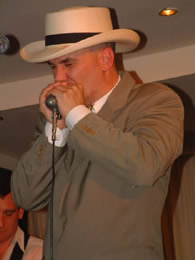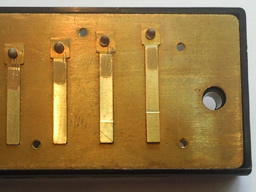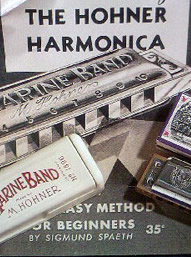Beefing Up Those Bends – 3 Draw Bends
‘Be lion-mettled, proud, and take no care who chafes, who frets, or where conspirers are’ Macbeth (Shakespeare)
 Brace yourself and take a deep breath. It’s time to face everyone’s worst harmonica nightmare – the three witches. They’re the three hole draws to you and me. As you are no doubt aware, if we exclude the overdraws in hole 10, this is the hole that carries the most bends. And they’re the ones we secretly dread. They never sound as strong as other notes or bends across the harp (even in the hands of the masters) and they never quite do what you want them to. I’ve heard many players camouflaging the reed’s inherent imprecision with vibrato or else they just don’t go there. Like the inconvenient pattern swap across holes 6 and 7, subconsciously we wonder who designed such a frustrating tuning system in the first place.
Brace yourself and take a deep breath. It’s time to face everyone’s worst harmonica nightmare – the three witches. They’re the three hole draws to you and me. As you are no doubt aware, if we exclude the overdraws in hole 10, this is the hole that carries the most bends. And they’re the ones we secretly dread. They never sound as strong as other notes or bends across the harp (even in the hands of the masters) and they never quite do what you want them to. I’ve heard many players camouflaging the reed’s inherent imprecision with vibrato or else they just don’t go there. Like the inconvenient pattern swap across holes 6 and 7, subconsciously we wonder who designed such a frustrating tuning system in the first place.
The message from the Good Doctor is deal with it. Embrace the challenge and don’t shy away. OK, our ears can detect the tonal imperfections, but so what? No cracked eggs, no omelette. It may be the weak spot on the harp, but it’s also part of it’s character and charm. Make it yours. So let’s feel the fear and do it anyway. Follow me..
Getting you started – focus!
To play each of the three bent notes cleanly will take months of dedicated practice, and even then you will need to make in-flight adjustments.You could use another musical instrument,  electronic device or software to help zero in on the target notes. The Bendometer is a great free software application you can download for this purpose. iPhone also has a digital tuner gizmo you can upload. But can you carry a Bendometer around with you or do you have an iPhone contract? What if you forget to charge your phone?
electronic device or software to help zero in on the target notes. The Bendometer is a great free software application you can download for this purpose. iPhone also has a digital tuner gizmo you can upload. But can you carry a Bendometer around with you or do you have an iPhone contract? What if you forget to charge your phone?
Instead, why not learn a tune or lick that demands some, or all, of the bends in draw 3 and use your ears to determine whether or not you are hitting them accurately? When you get the chance, record yourself and play it back. I guarantee it’ll make interesting listening. Some suggested melodies are tabbed for you below. So why not leave the science behind and use the force? “Leave the science behind and use the force.” By this I mean learn to anticipate notes in your head and go for them unassisted. It’s exactly what you do when you sing or whistle. Once you are underway, listen to yourself and learn to make micro-adjustments to deliver your chosen melody or lick as perfectly as possible. Enjoy the experience of playing openly and freely. You will make mistakes, but that’s a good thing. Learn from them. What’s the worst that can happen? Are the Bend Inspectors going to knock at your door? I think not, but here’s how to prepare if they did..
Developing your harp guns in four easy stages
We’ll assume you have located all your 3 hole draw bends, but haven’t yet perfected playing them in isolation. You’re still relying on a scoop down from the clean draw or you fudge over it all with a wavering vibrato effect. (If you have perfected playing them directly, you may still find this exercise useful in maintaining your bending muscles. Add it to your ‘harp gym‘ regime). Hitting bends accurately, without scooping, is known as direct bending – a skill which is central to controlled playing. If you haven’t yet attempted any bends at all, take a look at the draw bend page on our Harp Skills menu and tackle an easier hole such as draw 4 or draw 1 first.
 Stage one
Stage one
We start by moving from the draw note down to the full draw bend as slowly as possible. Don’t worry about the bends you’re passing over at this stage. The objectives are to maintain a good tone (no loose air), a respectable amount of volume and to control your descent. Now do this again, but save enough lung capacity to hold the full bend down as long as you can. Remember – descend as slowly as possible first.
Now let’s extend the exercise by moving slowly down to the full bend, holding the bend without wavering and then releasing it by degree (slowly) back to the clean draw.“it’s one of the hardest things to do on the harp” Don’t worry if this is more difficult than the descent, that’s normal. In fact it’s one of the hardest things to do on the harp. Work at it, developing control as you do. This exercise alone is making you ten times better than many intermediate and advanced players! Remember, the more slowly you do this exercise, the more control you will develop. Don’t rush it. You’re building the muscle necessary for direct bending, while imprinting the required positioning into your chops, jaw and vocal tract muscles.
Stage two
Learn to play from the draw note slowly down to the full draw bend, out to the blow note and back again, sounding each tone (straight draw, full draw bend, blow, full draw bend, straight draw) individually without any scooping. The tab looks like this: 3D 3D”‘ 3B 3D”‘ 3D. At this stage we’re still not worrying about the interim first and second draw bends. Be patient, we’ll deal with them later.
 The difficult part is returning from the blow note to the full draw bend without relying on an interim scoop down. Try the move and listen closely. Or else record yourself and play it back. Are you scooping? Be honest with yourself. You need to direct bend using all your newly acquired control. If this doesn’t happen at first, don’t despair. Go back to stage one and get those muscles educated. Then try this stage again. Once you have cracked the process, why not repeat it in holes 1, 2, 4 and 6 and explore the different character of those reeds (there are links to related articles at the foot of this post)?
The difficult part is returning from the blow note to the full draw bend without relying on an interim scoop down. Try the move and listen closely. Or else record yourself and play it back. Are you scooping? Be honest with yourself. You need to direct bend using all your newly acquired control. If this doesn’t happen at first, don’t despair. Go back to stage one and get those muscles educated. Then try this stage again. Once you have cracked the process, why not repeat it in holes 1, 2, 4 and 6 and explore the different character of those reeds (there are links to related articles at the foot of this post)?
Stage three
Time for the big one. You’ve learned to move with control from the straight draw, slowly down to the full bend, out to the blow note, back to the full bend without crutches and release slowly back to the straight draw right? Fantastic! “All you need to do is stop the bus along the way”All you need to do is stop the bus along the way. Straight draw to first bend involves a small adjustment of the tongue and a tiny push (or tightening) from the lips as your start to transfer the control point towards your throat. First bend to second bend involves no changes in the lip pressure, just a partial retreat of the tongue, from ee to yoo. Now to the familiar full bend, from yoo to your, together with a definite expansion of, and pulling sensation from, the rib cage. Now reverse the process slowly. This is the real deal and it’s hard. You may find tilting your chin down and arching your neck slightly helps provide extra room for manoeuvre. Do this a few times and perfect your control. Congratulations, you are almost a 3 hole Jedi Knight.
Stage four
Well done for sticking with it. All you have to do now is put your new skills into context. Match practice.This means playing tunes which demand good use of the three hole bends. Start with one we all know. Amazing Grace. It can easily be played in the upper octave using blow 6 as the root, in which case no bends are necessary. But the higher octave can become shrill after a while, so it’s great to add variety by dropping down to draw 2 as the root. The only catch is you will need the second draw in hole 3 to replace the straight draw 6. Then try Love Theme To The Godfather.It’s a beautifully romantic melody requiring all three draw bends. And as a last challenge, we have it on good authority that the melody Bye Bye Blackbird is a great test of the second and third draw bends in hole 3. May the Force be with you.
Amazing Grace
1D 2D
3D 3D” 2D 3D
3D” 2D
2B 1D
1D 2D 2D
3D 3D” 2D 3D
3D” 4D 4D
3D 4D 4D
3D 3D” 2D 3D
3D” 2D
2B 1D
1D 2D 2D
3D 3D” 2D 3D
3D” 2D 2D
Love Theme From The Godfather
3D” 4D 5D 5B 4D 5D 4D 5B 4D 3D’ 4B 3D”
3D” 4D 5D 5B 4D 5D 4D 5B 4D 3D” 3D”‘ 2D
2D 3D’ 4D’ 5B
2D 3D’ 4D’ 4D
1D 2D ” 4B 3D’ 3D”
4B 3D’ 3D’ 3D”
3D” 1D’ 1D
4D 4D 4D’ 4B 5B 4D 3D’ 3D”
3D” 4B 3D” 2D
2D 3D’ 2D 3D”
4D 4D 4D’ 4B 5B 4D 3D’ 3D”
3D” 4B 3D” 2D
2D 3D’ 2D 3D”
3D” 4D 5D 5B 4D 5D 4D 5B 4D 3D’ 4B 3D”
3D” 4D 5D 5B 4D 5D 4D 5B 4D 3D” 3D”‘ 2D
2D 3D’ 4D’ 5B
2D 3D’ 4D’ 4D
1D 2D ” 4B 3D’ 3D”
4B 3D’ 3D’ 3D”
3D” 4D’ 4D
Bye Bye Blackbird
3D 3D 3D 3D 4B 3D 3D
3D 3D” 3D”
3D” 2D 2D
2D 3D” 2D 2D’
4B 4B 4B 4B 4D 4B 4B
3D 3D” 3D”
2D 2D 2D’ 2D’
3D” 3D 3D” 2D
3B 4D 4D 4D 4D
4B 3D 3D” 3D” 3D”‘
2B 4B 4B 4B 4B
3D 3D” 2D 2D 2D’
3D 3D 3D 3D 4B 3D 3D
3D 3D” 3D”
3D” 2D 2D
3D” 4B 2D’ 2D
OK, and now you switch to the chromatic and run it off like this…
Related articles

The link for amazing grace was nullified by youtube. Thank the Lord for Godtube, which isn’t as closely monitored by EMI:
http://www.godtube.com/watch/?v=CC90MNNU
That vibrato from 3:18 to 3:27 is unbelievable.
Best wishes
John
In what position is the tab for Bye Bye Blackbird ?
thats a problem for me, even knowing the tune , in what key ( position ) am I ?
Hi Tonio – look for the point of resolution and see if that offers any clues. In other words, what seems to be the root note, or drone note, where everything comes back to (resolves) in order for the song to sound complete? Usually the final tabbed note, or last note we play will give us the answer. In this case 2D. Now which position most regularly uses 2D as it’s root? Answer 2nd position cross harp. Hope this helps. Look at Amazing Grace and The Godfather Theme above and follow the same process each time. What positions are they in?
The key, meanwhile, is an entirely different subject. I could say any key you want! But the skill is listening to the track, or the band, and working this out for yourself. Then deciding which harp to use for the job, positionally speaking.
I can’t even sound the whole and a half tone bend. Got any advice?
Go to our Harp Skills menu and start with the basics of bending. Should keep you busy for a bit.
Amazed to see that this link has been going 5 years but I guess note bending is a perennial problem. It is for me but I wonder what you think of tuning the harp? Is it cheating? I have tuned harps as well as untuned ones which I diligently practise with to bend the “natural” way. One harp I have tuned is an A Crossover marine band.By filing the reed tip I flattened the draw 3 down to G and sharpened the draw 6 up to G. This is only way to get that high note in Canned Heat’s ‘On The Road Again’. It’s great for that song but I do use it for others as well.
I should have said the reed base (not tip) to flatten the draw 3. Conversely, I filed the draw 6 tip to sharpen the note to G.
Hi David,
Thanks for stopping by again. In my opinion you have to have the tools for the job. And I don’t just mean files and feeler gauges. Working out the song key and note sequences needed is the first important step. The next step is selecting the right harp key and position to match the song’s mood.
Now, there will be songs where two or three different positional solutions are possible, each with its own advantages and disadvantages. And the best fit may come down to what the individual player finds most comfortable, working from his/her existing skill set. The developmental opportunities of exploring the other options should not be dismissed in the process however!
In using this positional approach, in my opinion you are strengthening your ability to emulate the greats, and also to master standard draw/blow bending skills. This gives any player a very solid foundation.
But things have moved on since the classic pre- and post-war blues periods. By retuning his harp for the job, Al Wilson was breaking new ground in many ways. Or else rediscovering long forgotten skills from the 1800s; the ‘standard’ Richter tuning could be regarded as revolutionary in its own right. Adopting the same can-do mindset and engineering our own adjustments as harp players is, in my opinion, essential. And it’s not cheating as long as the journey mentioned in the previous two paragraphs has already been achieved (or is in progress).
Let’s be honest, guitarists retune all the time – are they cheating? No, they’re either finding solutions or adopting tried and tested tuning conventions (open G for slide guitar is one example, Spanish tuning for other occasions is another example).
So retuning is a very good thing. And it’s not cheating, just as long as you can cut it with the basics when called upon; these should arguably include positional playing in all seven modal positions, standard draw and blow bends, AND overbends! From your comment, I reckon we’re in agreement.
PS I have also come to believe that interval playing is a hugely overlooked area for exploration.